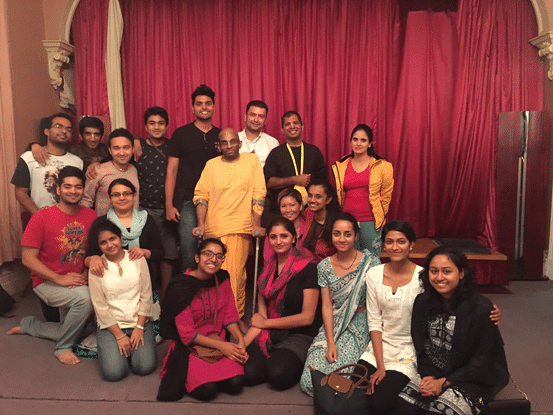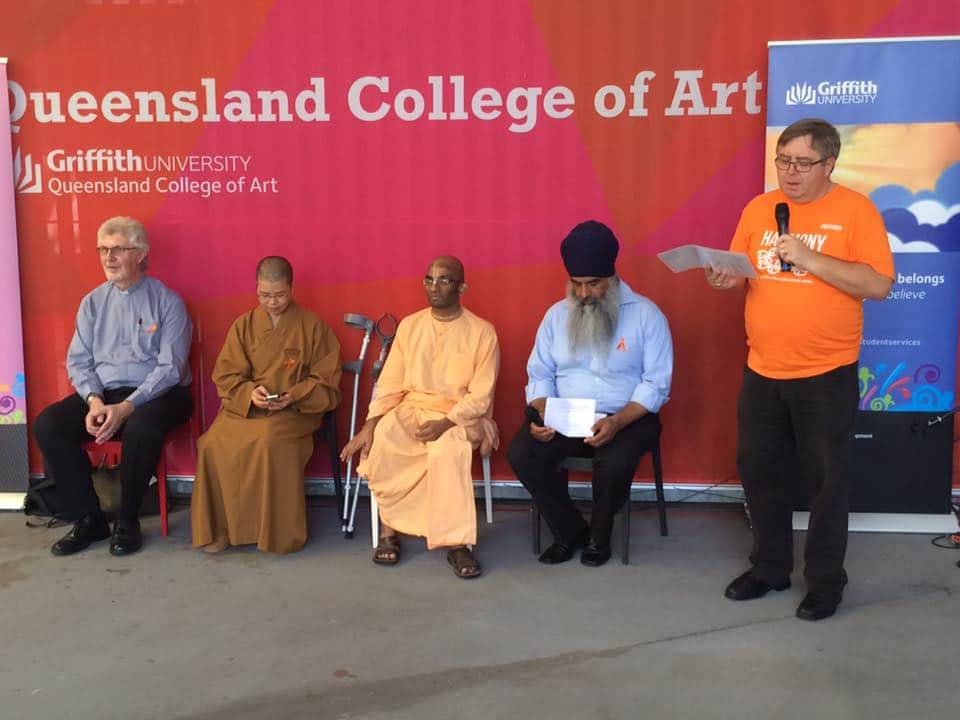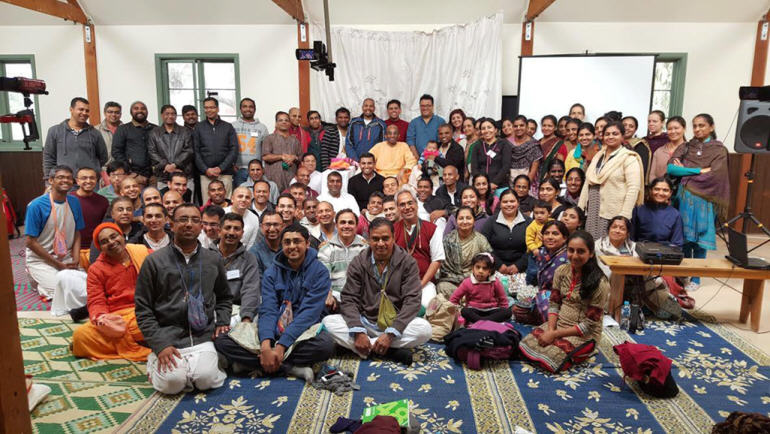Near death experiences on the road (Part 02) (Reflections on 2016 Australia-Singapore trip)
Continued from part 01
Talks to Western audiences
Due to a slight scheduling glitch, my visit to Australia occurred when the college semester had just started, so not many college programs could be arranged. Still, I had a few programs for Western audiences.
After my talk “You are bigger than your habits” at the University of Queensland in Sydney, a student asked whether our emotions are caused by our brain chemicals. I explained that the question got the causality wrong: the secretion of chemicals is primarily the result of emotions, not their cause – just as laughter is primarily the result of happiness, not its cause.
In a talk at Urban Yoga in Melbourne, I spoke on “Discover your inner power,” where I divided the talk into four parts, each part focusing on one word in the title: discover – appreciating the spiritual underpinnings of discovery; your – understanding the real you; inner – grasping the complexities of our inner world; and power – linking with the source of all power. After the talk, an Australian boy asked several brilliant questions about quantum physics and consciousness. This turned out to be the most in-depth scientific discussion I have ever had after a class. I have spent hours and years studying science and spirituality and I felt enlivened to see that knowledge coming to use in my speaking.
At the Queensland College of Art, I was part of a panel discussion, wherein I, as a representative of Hinduism, along with representatives of Christianity, Buddhism and Sikhism, spoke on “How faith contributes to harmony.” I started by explaining that the hope for harmony itself rests on faith – if we were just selfish genes geared for survival in the struggle for existence, the stronger among us would prey on the weaker, even in the field of religion. Only because we have the faith, even if unacknowledged, that we are more than our biological drives do we enquire about harmony instead of hegemony. The more we understand how our spiritual core transcends our biological shell, the more we can see our essential commonality with everyone and progress towards harmony.
During the QA session, the MC asked the panelists what faith exactly is. Quoting the Gita (17.03), I explained that faith is the substance of our being – our faith is what makes us who we are. Thus, even atheists have faith: faith in their faithlessness. The more our faith is rooted in knowledge of reality, the more our existence becomes grounded in truth and we relish true happiness.
Later, a Christian youth mentor who had attended the meet told me that the explanation of faith as the substance of our being was the most concise understanding of faith he had ever heard.
“From Dharma to Prema” Retreat at Melbourne
The highest point of the whole tour was the two-day retreat on “From Dharma to Prema” held at a scenic resort on Comfort Hill a couple of hours drive from Melbourne. Thanks to the vigor of Muralidhara Prabhu, who was the main organizer of my Australia tour, and his team of dedicated devotees, one hundred and sixty devotees participated in the retreat, which was organized with remarkable competence.
Basing my analysis on the Ramayana and drawing from the Madhurya Kadambini, I spoke on how lofty-seeming philosophical principles such as surrender can be practically applied. We had two sessions dedicated to question-answers and I was humbled by the sincerity and seriousness of the several dozen questions that came up. In fact, so many questions still remained after the retreat that an additional QA session was organized on the eve of my departure from Melbourne.
After the retreat, an Australian lady, who is a nurse in a mental health hospital, said that she could relate with my classes because she sees daily the misery that the mind causes in people’s lives. She added that she had learnt more about life in these two days than what she had learnt in nearly three decades from Catholic theology and nearly a decade from Buddhist practice.
A devotee said that he was delighted to hear my QAs live after hearing them recorded for nearly three years. He had found my site on google at a time when he had been on the verge of converting to Islam. One of his Muslim colleagues had given him videos of an aggressive Islamic preacher who lampoons Hindu beliefs and practices. Just before converting, he had decided to make one last effort to find answers – and had been relieved and delighted to find all his questions answered on thespiritualscientist.com.
Sadhu sanga
At Canberra, where I had gone for Gaur Purnima, I got the association, more through actions than words, of the Temple President, Adi Purusha Krishna Prabhu, who is a Prabhupada disciple. As the temple is heavily understaffed, Adi Purusha Krishna Prabhu himself came to receive me at the airport and offered his own office as the room for my residence. I was embarrassed by his humility and protested, but had to surrender to his loving insistence. When on the morning after Gaur Purnima, I went to the temple hall for darshan before rushing to catch my flight, I was touched to see the dedication of one South American mataji who was doing both the arti and the singing – she was the only person in the temple hall. My Canberra visit served as a moving demonstration that a yatra, even when struggling, can continue by the dedication of a small group of devotees.
At the Muruwillambah farm, Ajita P, the Temple President, explained that their aim was to provide Westerners an opportunity to practice bhakti within their comfort zone. The word “comfort zone” usually has a negative connotation, for it is associated with complacency and lethargy. But it soon became clear to me that he used it positively, to signify a situation where bhakti is not made more difficult than it needs to be. During my journaling, when I reflected on his words, it struck me that the whole system of varnashrama is in one sense an arrangement meant to provide people spirituality within their comfort zone. People’s own nature is their comfort zone; when they are provided vocational and spiritual engagements according to their nature, they can comfortably contribute to society and progress towards Krishna. During my student days when I was introduced to spiritual life, I was provided bhakti within my comfort zone through the youth centers, wherein spiritual practices were appropriately adjusted to be manageable with our college schedule. I am not sure whether I would have started practicing bhakti as a student if its practice hadn’t been thus customized. If providing bhakti within the comfort zone of Indian students is fine, why should providing bhakti within the comfort zone of Westerners be objectionable? Undoubtedly, the extent of the adjustments needs to be moderated to ensure that the core of the bhakti tradition is not compromised. Nonetheless, our tradition has always exhibited flexibility to accommodate people of different folds, and faithfulness to tradition also includes faithfulness to the tradition’s flexibility.
In Melbourne, I got the sanga of HH Bhanu Maharaj, who had been there for Gaur Purnima. I have served Maharaj by editing some of his books and I have found inspiring his single-mindedness in translating our acharyas’ works into English. We discussed the challenges of balancing intellectual work such as translating or writing with the demands of traveling and preaching, and he stressed the need to maintain one’s introspectiveness even when being among people and being on tour. As Maharaj spoke insightfully on several topics, I was struck at how being a dedicated transmitter of our predecessor acharyas’ words doesn’t decrease one’s own individuality, but instead sharpens it – the acharyas’ wisdom becomes like the chisel that brings out one’s best.
At Singapore, I had a fruitful meeting with the temple president Devakinandan Prabhu. He is well-known for his sweet classes on the Bhagavatam, and we bonded quickly, especially on the topic of sensitivity in outreach. ISKCON’s Singapore yatra is a tragic example of insensitivity leading to hostility, thereby making outreach unnecessarily difficult. In the 1970s, devotees went to Singapore and started preaching, with their primary audience and allies being the Hindu community there. Unfortunately, some overzealous devotees started criticizing the worship of the devatas in programs organized at those very devatas’ temples. The local Hindu community got so irked that they complained to the Singapore government, which promptly banned ISKCON. That ban continues till day despite the present generation of devotees having strived diligently to heal the wounds caused by the previous generation’s insensitivity. When I described to Devakinandan Prabhu my Brisbane seminar on “Cultivating non-judgmental attitude,” he invited me to come again during a long weekend to conduct that seminar in Singapore.
As ISKCON is banned in Singapore, devotees can’t enter there in clothes that mark them as devotees. So, while going to Singapore from Perth, I had to do renunciation of renunciation for devotion’s sake. That is, I had to renounce my renouncer’s robes and wear a civil dress. I felt odd initially as I was wearing a shirt-pant after nearly two decades. But soon as I got absorbed in writing on the flight, I forgot about what I was wearing. We are meant to see beyond the body to the soul; so, it was heartening to see that I didn’t get too hung up about the clothes, which are superficial even to the body.
At Perth, Bhurijana Prabhu had insisted that I stay at the farm where he and his wife Jagattarini Mataji stay. Mataji has pioneered a superb art exhibition called “The Sacred India Gallery,” wherein she has personally designed several dioramas comprising hundreds of small figurines. The dioramas depict various places and pastimes in Mayapur, Puri and Vrindavan, thereby giving visitors a vintage experience of spiritual India. One of her dioramas has even won the top prize in a local contest. She explained how she had tackled the challenges in pursuing artistic excellence in our movement, which is geared primarily towards direct preaching. By hearing her experiences, I felt encouraged and edified in tackling the challenges I face when pursuing writing more as an art for glorifying Krishna than as just a tool for outreach.
The most sobering and illuminating association I had was of Bhurijana Prabhu. He is currently writing a detailed commentary on the Bhagavatam and I was inspired to see the sheer amount of hard work he is putting into it, despite having a stiff neck and several other health problems that make writing difficult. When he asked me how my Australia tour had been, I started telling about my various programs and the positive responses. After patiently hearing me for a few minutes, he suddenly cut in and said, “Such words will kill you. If you keep hearing from people how great your classes are, that can be fatal for your humility and your bhakti. As a spiritual master, I regularly hear people telling me that I have enlightened and saved them. And in the face of such praise, I know how difficult staying humble is. Remember that those who glorify you can be dangerous for your spiritual life.”
Later, when I journaled about his jolting words, it struck me that whenever I preach, I am near death – near my spiritual death. Preaching is an opportunity for me to go closer to Krishna by deepening my absorption in his message. But it also presents the temptation to go closer to my ego and closer to my spiritual death. I am grateful that Srila Prabhupada has provided me spiritual guides who remind me to make the right choice.



